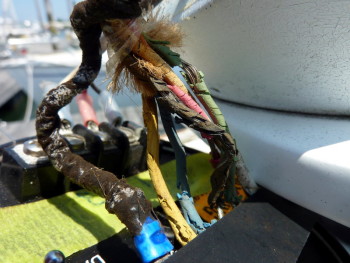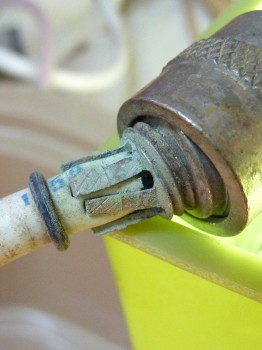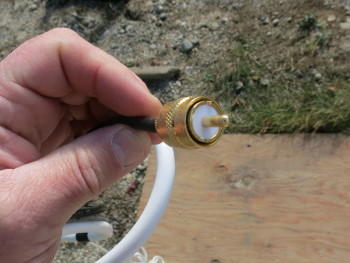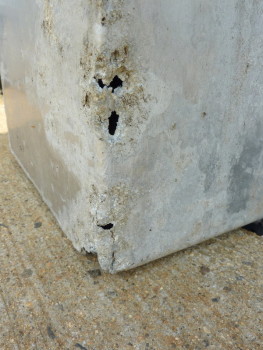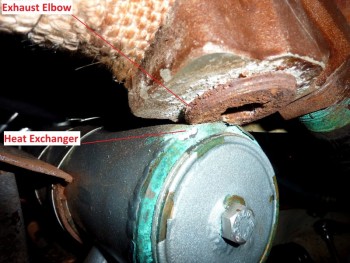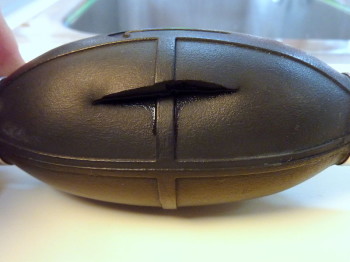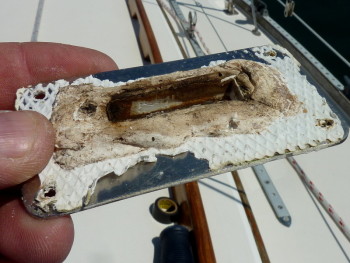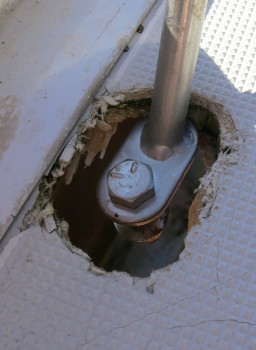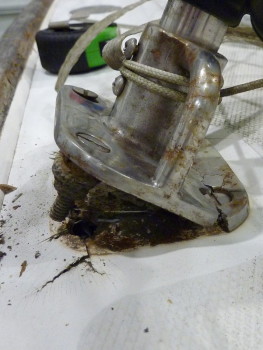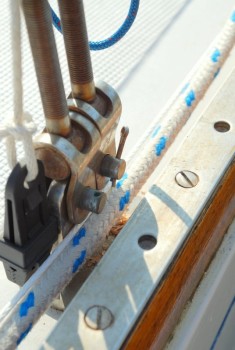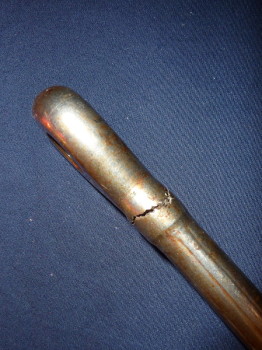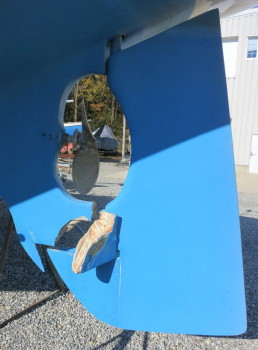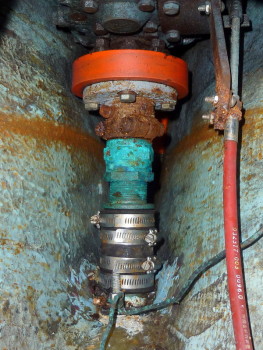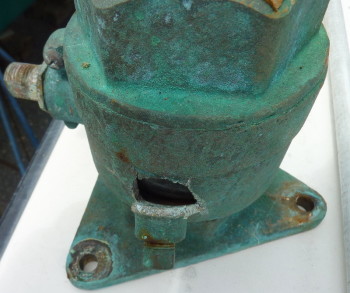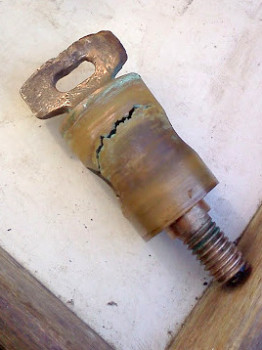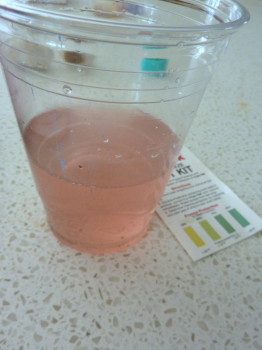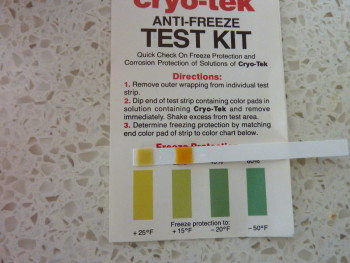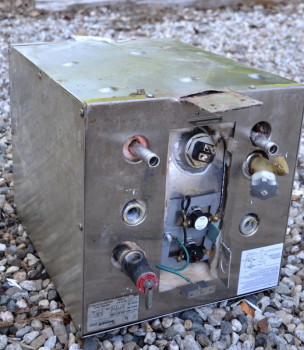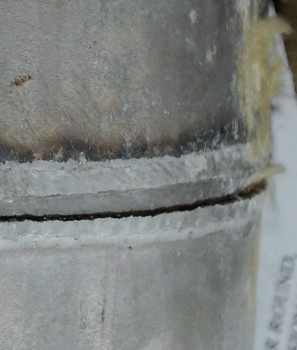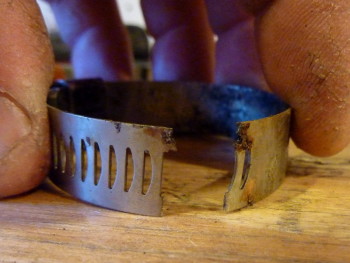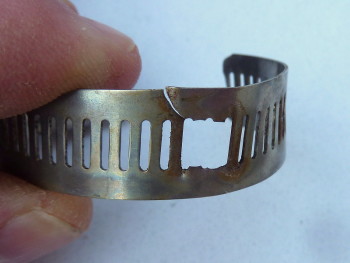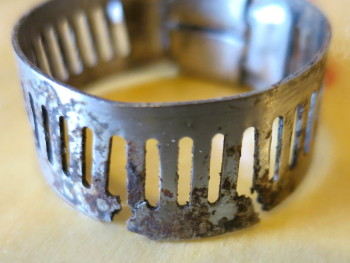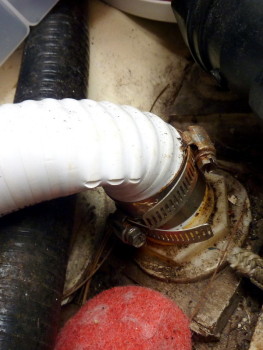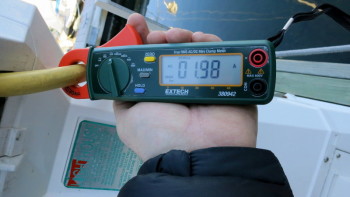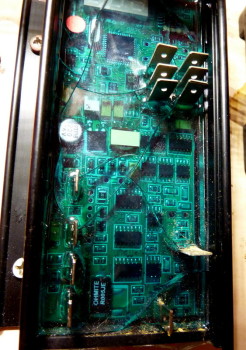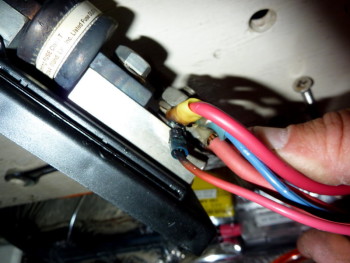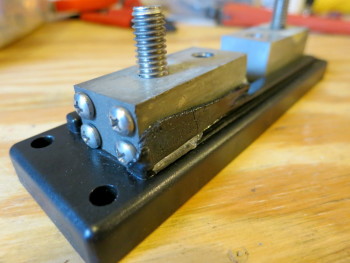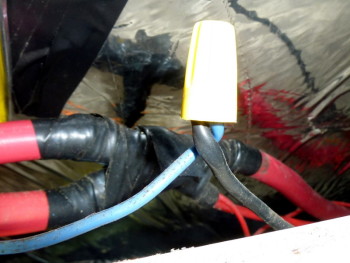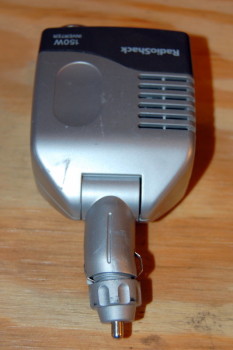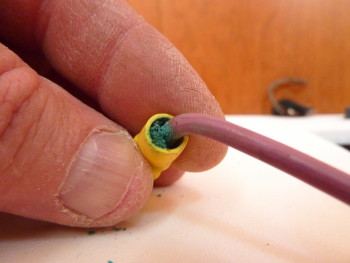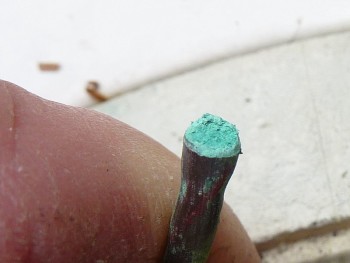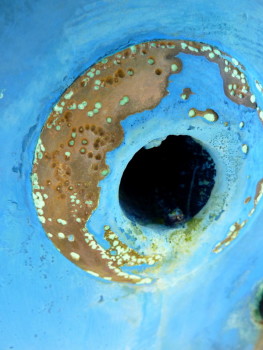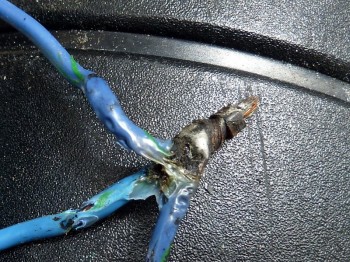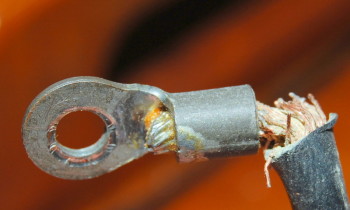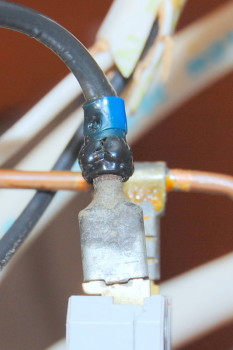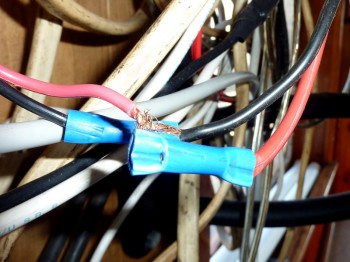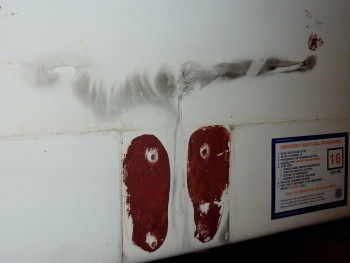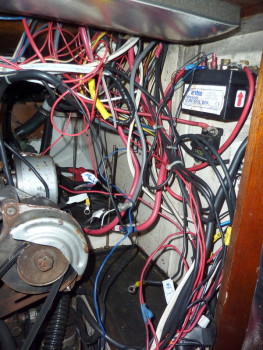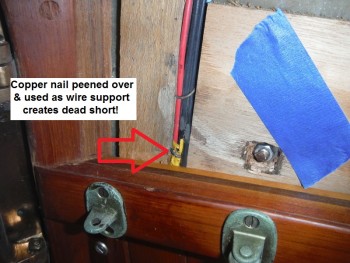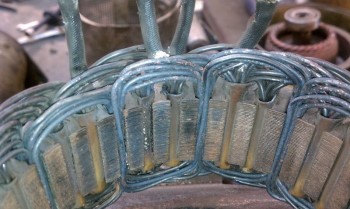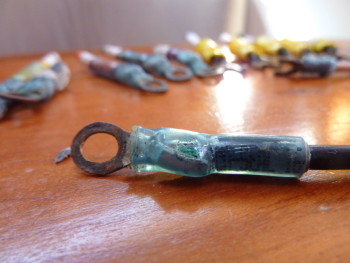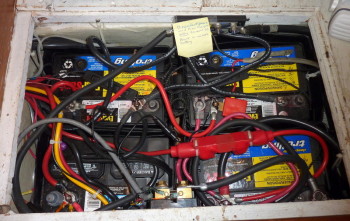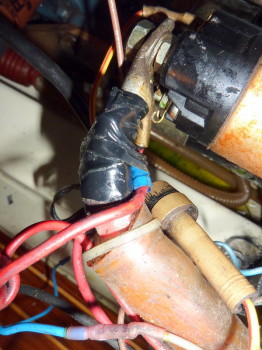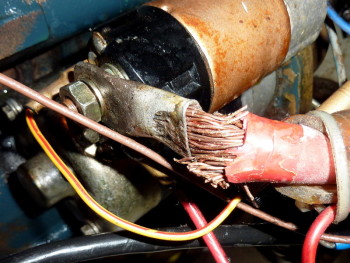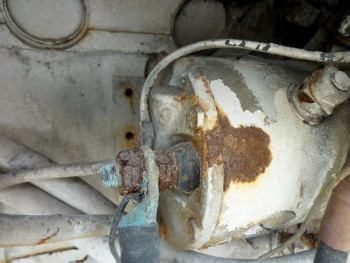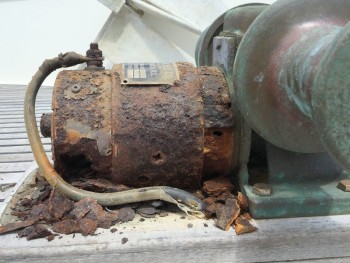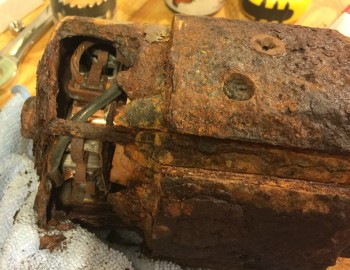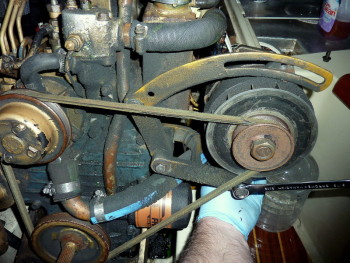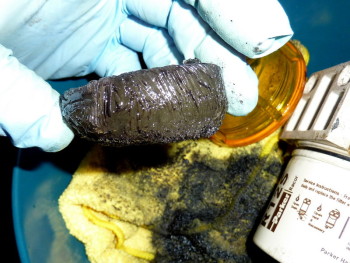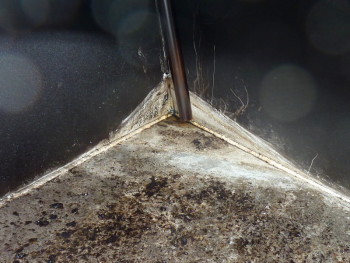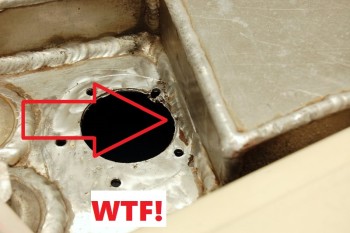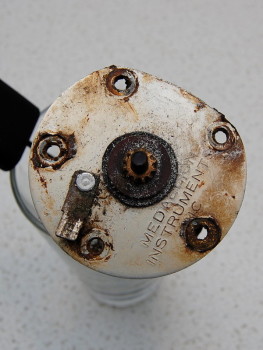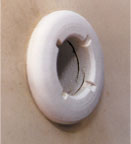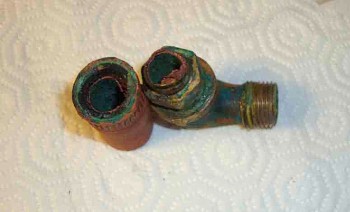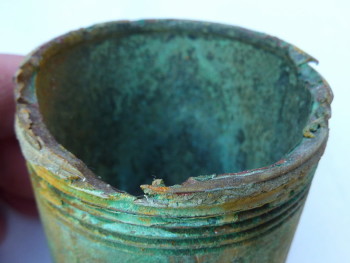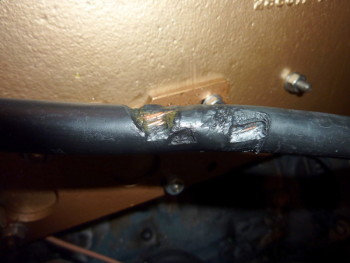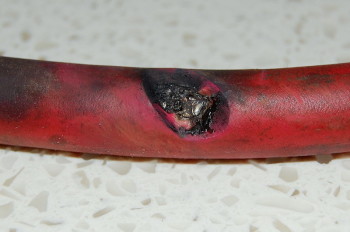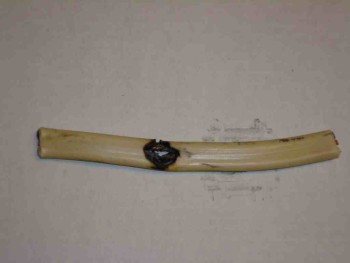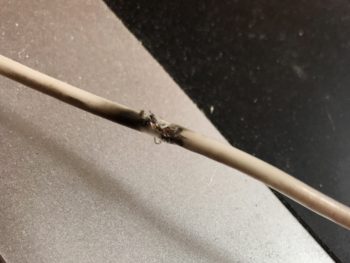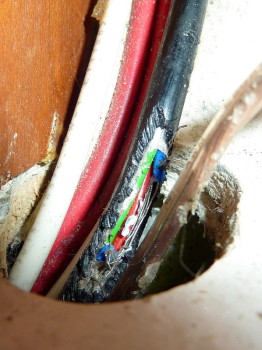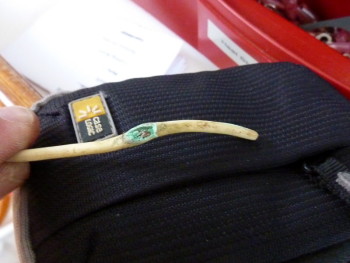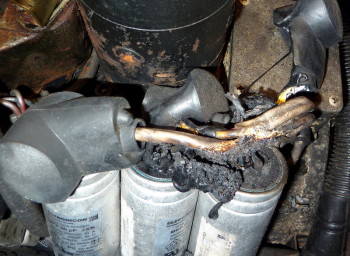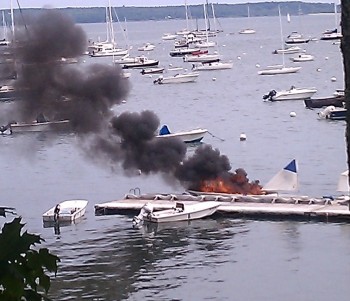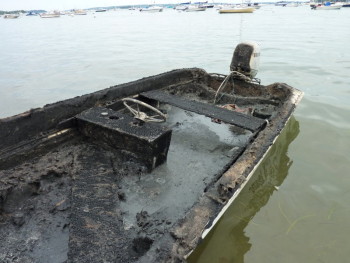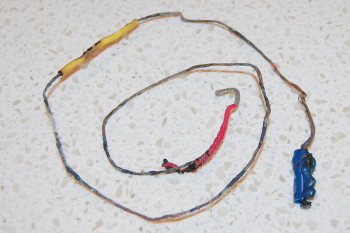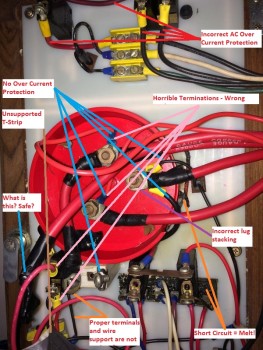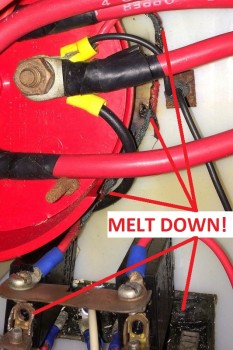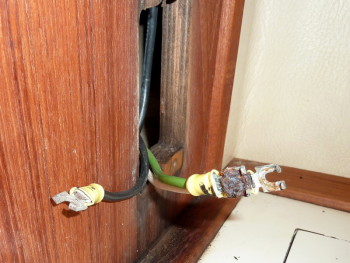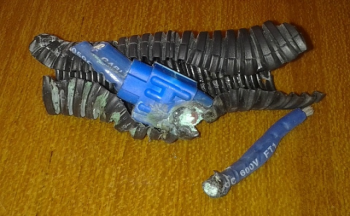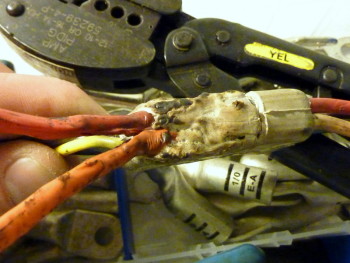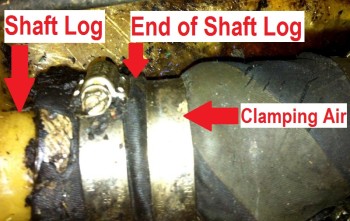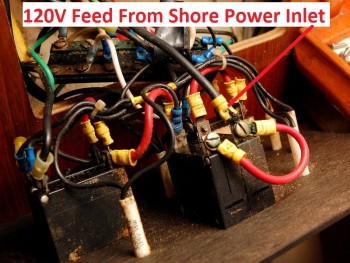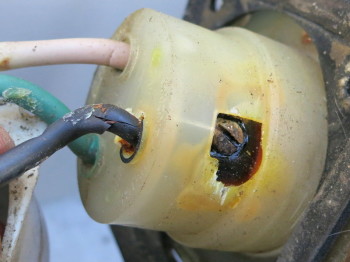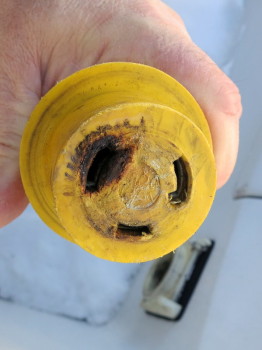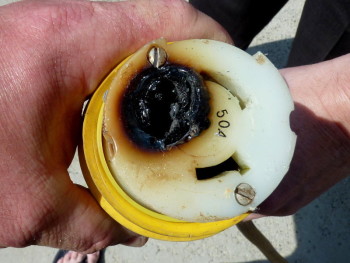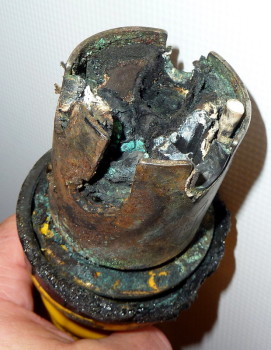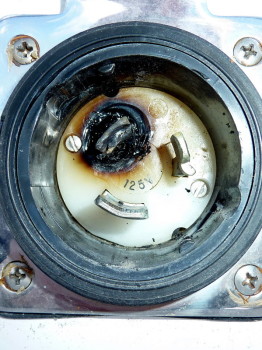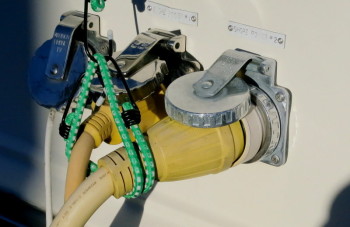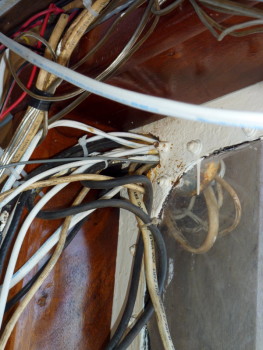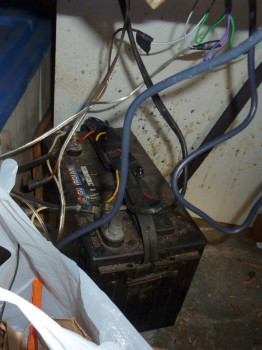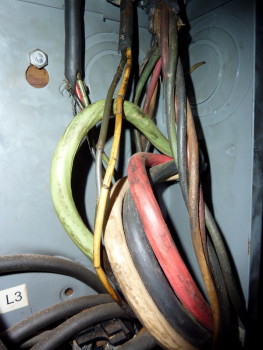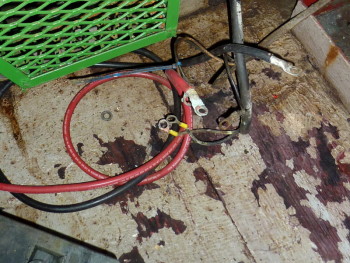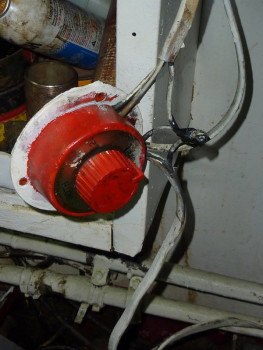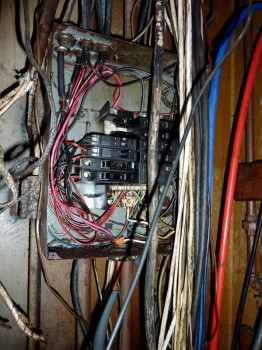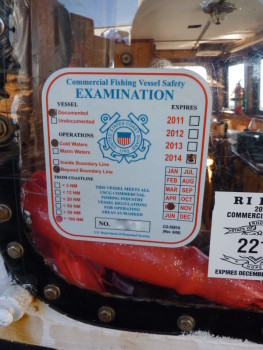Proper Wire Is A Must
This is not a joke. Rubber jacketed wire (EPDM) was used in place of proper marine rated & PVC jacketed wire.
All wire is not created equal…
NOTE: Click on any image to make it larger
One of My Biggest Peeves
This is a Shakespeare PL-259 Center Pin VHF connector. The only thing they do easily is FAIL!!!
I replace more of this terminal than just about any failed terminal on a boat.
Someday someone is going to die because one of these crappy, easy to install, connectors failed to allow a VHF transmission.. Arghhhhh…..
Don’t Let The Age Fool You
This Shakespeare Pl-259 Center Pin Connector had less than four weeks of use before it FAILED TO WORK…..
A Raymarine ST-60 Wind Transducer
The plastic barrel nuts on these ST-60 wind transducers fail at a rather alarming rate. Some of them just disappear right over the side of the boat. This owner was lucky, it landed on his deck.
If this was the first one I’d seen FAIL I’d give Raymarine a pass, but I have seen far to many of these FAIL for this to even be laughable. Heck the ST-60 wind on my own boat has failed just like this, but this was a customers ST-60…
A Real Bright Idea…..
This builder thought it wise to use aluminum for a holding tank. This boat was just three years old!!!!!
Lets see, human waste & uric acid + aluminum oh yeah = HOLES……
Covered under warranty…? Ha, ha, ha, ha, ha, that’s funny……. Not!
When The Boat Yard Installed…..
When the boat yard installed this new heat exchanger….. Well, you get the idea..
Nasty Diesel Leak
1- There is not a single fuel priming bulb I can find certified for below deck use. This one was used to prime a Racor fuel filter after filter changes..
2- It SPLIT and leaked nearly 75 gallons of fuel into the bilge.
3- The boat still smells to this day…… (EDIT: Owner finally sold boat due to lingering diesel odors)
4- Please try to use sound best practices when installing below deck fuel systems..
Previous Owner Blues
The previous owner of this boat thought silicone was a great bedding material. When the current owner got the boat every single chain plate was leaking. He excavated & attempted to remove the old silicone to the best of his ability and re-bedded it with 4200…. It FAILED……
NOTHING LIKES TO STICK TO SILICONE RESIDUE!!!!!!!!!!!!!!!
Wet Decks……
Wet decks can lead to potentially life threatening situations, especially when we are talking about lifeline stanchions. There was literally no solid core left under this stanchion gate brace….
The deck area surrounding this was pegged on the Electrophysics moisture meter.
Another Previous Owner Fail
At some point the previous owner took this stanchion off and reinstalled it. So, what’s the problem with that you ask??
It was installed with dinky little washers, with zero backing, and NO BEDDING COMPOUND WHAT SO EVER..
The deck core turned to wet mush and when pressure was applied to the lifelines SNAP, RIP, CRUNCH….
Remember these are called LIFElines….
This Owner…..
This owner was fueling up and literally, at that moment, heading off shore from Maine to Maryland when I noticed his rigging. FAIL!!
This Boat
This boat was advertised as;
“Bristol condition, sail away ready, recent sails & standing rigging.”
She was a cesspool with NOTHING good about it, especially this beauty..
Standing rigging looked to be the same age as the boat, 41 years old!
Marine Marketing 101: Don’t believe everything you read!
But, But, Wait……
But, but I read on the internet that blue-water-boat skeg-hung rudders can’t FAIL………
Well then, I guess you saw it here first….. (wink)
“Hey RC I Have A Grinding Noise?“
Ah, yes you do…… Come on, really…..????
DIY Winterizing FAIL
But Yogi the Ranger’s not going to like this……..
Proper seacocks have drain plugs for a reason, THIS REASON!
Improper Winterizing Of A Seacock
I have seen this one all to often. A very expensive tapered cone seacocks split open by frozen water..
Cha-Ching $$$$$$$…..
Winterizing FAIL
This owner thought it a reasonable approach to save $6.00 on propylene glycol antifreeze. He decided to suck just two gallons of -50 PG into his expensive engine. Once he “saw pink” out the exhaust he immediately shut the engine off.
Sorry to break it to you but merely “seeing pink” arrive at the aft end means SQUAT unless you previously KNOW exactly how much it takes.. If in doubt please MEASURE the concentration coming out the exhaust, by catching it in a cup, and then testing it with a sight refractometer.
Alternatively spend the extra $$ & suck in a couple more gallons of PG. The concentration coming out the wet exhaust should match what it went in at.
This owner froze and split his expensive heat exchanger. It cost a hell of a lot more than the $6.00 he saved on antifreeze.
This is what remained inside the HX in the spring. Please understand that when you suck in a gallon of antifreeze it does not simply displace 1 gallon of water, IT MIXES with the water already in the system. Pre-diluted propylene glycol, and -50F PG is already heavily diluted, should not get diluted any further…
You may get away with saving a penny in the Mid-Atlantic region but in the far North you can run into serious trouble.
I Measured What Came Out
Seeing as it is next to impossible to photograph my sight refractometer, what is properly used to measure propylene glycol concentrations, I used a test strip specifically designed for PG..
DIY winterize FAIL!
As a point of reference this was two gallons sucked through a Universal M-25 diesel engine. I measured the freeze point of what was in the heat exchanger at just 25F… (ouch)
You Drain & Bypass a Water Heater
The drain cock on this water heater is there for a reason!
This owner sucked 6 gallons of -50F antifreeze into his system without bypassing the water heater……!
Freeze & split cha-ching $$$$$$$$$$$$$$$$$$$
DO NOT DILUTE PROPYLENE GLYCOL!!!
It would take far more than 6 gallons of antifreeze, in a 6 gallon water heater, to get zero dilution.
If you don’t know how to winterize you better know how to write checks…. D’oh!!
Water Heater Winterize FAIL
Here is another prime example of why marine water heaters are DRAINED & BYPASSED in the winter. This owner attempted to dilute the six gallons of water with seven gallons of antifreeze…. Seems reasonable right? WRONG!
Fill a 16 oz glass with milk. Now place it under the faucet and turn the faucet on. Let me know how many GALLONS of water it takes until the water in the glass is clear……. FAIL!!!!!!
Perforated Hose Clamp FAIL
I used to collect failed perforated hose clamps, but then my bucket got full……..
Want to be safe use non-perforated AWAB hose clamps.
This was the ONLY hose clamp on a head seacock… Lucky the hose did not blow off and it was only weeping water when I found the clamp in the bilge. Sadly for this owner that weeping water killed a $1600.00 bank of batteries over a 3 week period.
Please consider using non-perforated clamps instead.
One More…
Once again this was the ONLY hose clamp on a below waterline seacock!
This is why I do not like nor entirely trust perforated hose clamps. If using perforated clamps please use TWO for any connections that can become submerged or that are submerged.
Observe and check all below waterline hose clamps OFTEN……
Some Are Not As Easy To Spot
For Christ sake PLEASE stop using these sub standard piece of $hit hose clamps for below water applications!
As a best practice always double clamp below water…….
This one was spotted on a frozen OPEN seacock and this was the ONLY clamp….. D’oh….
Multiple Issues
I won’t be shy here. I am NOT a big fan of any PVC hose used for below waterline applications.
Why? I think this picture sums it up. This PVC “marine hose” was just four years old..
Also there is NO SEACOCK here to close off the thru-hull fitting for when these cracks finally let go…
PVC hose DUMB, no seacock DUMBER!!!!
Wanna Go Swimming……
Anyone up for a swim in this marina……??
AC Shore power FAIL!!!!
In fresh water it takes approximately 0.1A or 100mA to kill a human being. Here we have AC leakage, going somewhere, most likely into the surrounding water.
This is 19 times the lethal amount to kill a human in fresh water…… Ouch!!
Swimming in Marinas = DUMB
Electric Shock Drowning = VERY REAL
This Marina was in Brackish Water = VEGAS BABY
Cooked Regulator
Notice the cracking of the epoxy potting material on this expensive regulator. This Balmar regulator was installed less than 3″ from a very HOT engine manifold and literally cooked to death.
Common sense 101…?
Improper Lug Stacking Melt Down
This is a 350A Class T main battery fuse. It powered, among other things, a windlass and bow thruster.
Someone thought it was OK to install the smallest loaded wire and terminal on the BOTTOM and then stack the HIGH AMP loads on top of it.. This is a REALLY, REALLY, REALLY BAD IDEA!!
DO NOT DO THIS!!!!
The highest amp load terminals/wires ALWAYS go on the bottom and smaller loads stacked in order of potential load on top, to a max of FOUR TERMINALS PER STUD!
The bottom line here is that this almost started a boat fire. The fuse holder itself was physically MELTED..
IMPORTANT: High resistance can start fires well before a fuse or breaker trips..
This fuse holder had FIVE wires on it with the heaviest load on top of the four smaller wires….
“DANGER WILL ROBINSON“….
Fuse Holder Melt
This is what was left of the fuse holder from above.
Full MELT. This is fine for a grilled cheese sandwich, but not for your fuse holder..
The owner was very lucky this was caught in time. Keep a sharp lookout and keen eyes for FAIL……
Wire Nut Melt
There is a good reason wire nuts are verboten on boats… This is one of those reason.
The wire jackets entering this wire-nut are both MELTED from high resistance…
Wire nuts on boats = M-I-C-K-E-Y M-O-U-S-E, come on sing along……
Of course we can’t forget the sight for sore eyes in the back ground. Four 1GA battery cables were tied together with electrical tape and a 10X24 machine screw with no locking washer. You guessed it, they were also loose….
DUMB !!!!!
Please, Please, Please DO NOT use a 150W inverter in a 12V outlet!!!
When I boarded this boat the smell of burning electrical and melting plastic was awful. My nose led me to this melted 150W inverter which was charging a 17″ laptop computer…….
The 12V outlet was rigged with 16GA wire and NO FUSE…….
I see melted inverters like this more regularly than you’d care to know about.
Inverters have NO PLACE being plugged into a 12V outlet on a boat!
These devices are Darwin Award dumb….
A DC Leak
This is why open crimp terminals should not be used in the bilge area!
A proper heat-shrink butt splice or more properly routing the wires higher than the cabin sole, would have prevented the thousands of dollars in corrosion damage this 12V DC leak caused. Doh’…..
Solder Fracture FAIL
This wire was in a bilge and soldered into a bilge pump system. It fractured at the solder / wire juncture and fed live DC power into the bilge water. The owner noticed the boat sitting low and about to sink…….
If you don’t know how to solder, then DON’T….!
A HUGE Repair Bill $$$$$$$
This is one of the seacocks destroyed by the failed solder joint above…. Cha-ching $$$$$$$..
If you don’t know how to solder, then DON’T !!
If You Can’t Solder Then Please DON’T!!
Another solder FAIL…. If you look close you can actually see the terminal that broke off of this insulting mess……
Solder Embrittlement
This wire was starting to fail at the solder / terminal junction…
You Don’t Crimp Solid Conductor Wire……
1- Please don’t use solid copper wire on boats.
2- Please don’t crimp to solid conductor wire.
3- This is what a high resistance melt down looks like due to crimping solid conductor wire….
Ah Dude……
“My dad’s a TV repairman he’s got the ultimate set of tools..
In case it is not painfully obvious crimping the insulation only simply won’t cut it…. Doh’….
Jeff Spicoli would be proud…..
Who Let The Smoke Monster Out?
Once again improperly executed terminations lead to the smoke monster getting out of his cage….
“Hey RC I Need Some Help With My Wiring”
New boat owner and this is what he had to deal with.
When you read “kit boat” in the advertisement, well………. (wink)
Nail As Wire Support = Dead Short
I found this little issue on one of the supposedly well built Taiwanese boats. The builder decided that bending un-insulated copper nails over the non-duplex wire was a good way to create wire support.
Perhaps they never noticed that wire staples utilize a PLASTIC INSULATOR. Guess how long and how much of the boats headliner needed to be taken apart to locate this short….?
Sloppy builder tricks at its finest….
Fry Eggs on an Alternator Anyone…?
Large AGM battery bank + a dumb-regulated non temp-compensated alternator = FRIED STATOR!!!!!
What A Waste…
This owner paid $1.42 each for these expensive heat shrink terminals to be professionally installed.
It took one glance for me to discover the crimp tool used destroyed each and every terminal. Utterly ridiculous……
No, I’m Not Kidding….
Enough said….!
One Owners Idea Of A Termination
The red wire with blue terminal disappearing into the electrical tape was this owners idea of a good VHF radio 12V supply connection.
No over-current protection and only an electrical taped pressed connection against the starter cable….. WTF!!!
And Here’s The Starter Lug
This is why I was there, a complaint of a weak starter motor…. Huh, no kidding…
Vise-Grips are NOT crimp tools……
I literally pulled this wire out of the lug with my bare hands.
Using a proper crimp tool on this lug would require over 1000 pounds of pull force to get it out of the terminal.. I pulled it out with approx 10 to 15 pounds….. Freakin’ A dude…..
“Hey RC my Macerator Won’t Work?”
Funny, I can’t understand why… This terminal fell off in my fingers once the heat shrink was cut away.. I guess I will say it again..
PLIERS ARE NOT CRIMP TOOLS!!!
But hey the heat shrink was doing a very good job at hiding the inadequacies of the poor installation practices……
+1 for the heat shrink
-150 for the overall execution
We Can’t Even Count On The Factories To Get It Right…
These are decent quality DOUBLE CRIMP “Fast-On” or friction fit terminals. They are SUPPOSED to be installed with a double-crimp tool. One crimp is for the wire barrel and the second crimp provides strain relief.
The manufacturer of this product, Xantrex, used a DIME STORE quality crimp tool for a product intended to be directly connected to the BATTERIES!!!!
“But wait there’s more, buy now and we’ll send you two crappy products.”
Oh wait wrong commercial… Not only did Xantrex use the WRONG TOOL, they used the WRONG TOOL INCORRECTLY.
If using a staking or dimple-crimp tool the dimple ALWAYS goes OPPOSITE the seam!!!!
Someone please give Xantrex or their Chinese factory a lesson on proper crimping…… Sheesh…………..
This is a pathetically embarrassing example of corner cutting and cost saving at its worst. Sad really.
Shame, shame , shame on you Xantrex.
“Hey RC, my Engine Won’t Start?”
Jeez, I can’t for the life of me understand why….. Oh and note the excellent termination of the small black wire to this rusted mess…….
Interestingly enough this was a USCG Inspected off-shore fishing vessel with a CURRENT USCG sticker. I have confidence in our Government, do you….? (wink)
“Hey RC, my Windlass Stopped Working?”
Umm yes it did…
Every now and then it might pay to check on the windlass motor….
Cool, a New Style Swatch Watch Windlass Motor
Just like a Swatch Watch you can see the inner workings of this motor, how cool….
Wait, that window into the inner workings is not supposed to be there…..?
Replacement Alternator
This “professionally installed” alternator replacement was anything but professional. The new alternator had a 1/2″ pulley yet this engine uses a 3/8″ belt…. Can you say engine choking belt dust….
How any technician could walk away from a boat like this is beyond me. According to the owner at least two yards, beyond the original install, had looked at this and none solved the problem. Sad really because the issue is so darned obvious. One look at where the belt sits in the alternator pulley vs. the crank and water pump pulleys and it becomes painfully obvious. A new 3/8″ pulley solved these issues….
C’mon What Does a Freaking O-Ring Cost?
This fuel tank was full of water, including salt water..
Why?
The deck fill o-ring was completely missing as in NON EXISTENT!!!
This is the frozen mass of filthy water I took out of the fuel filter in mid winter.
A Siphon Break…..er.. BROKE!
This was one builders idea of a siphon break. They brazed some thin walled copper tube to a yellow brass nipple then placed it directly over the engine. It failed and began showering the diesel engine with salt water….. $1500.00 dollar later everything was just ducky………. FAIL!!!
My VHF performance Sucks…
Why golly, yes it does. Friction fitting a VHF cable and failing to execute the termination properly is a recipe for FAIL….. This level of absurdity on a SAFETY DEVICE is simply inexcusable.
Salt Water, Aluminum & Copper DO NOT MIX WELL
The white color of the bottom corner of this aluminum fuel tank was caused by a leaking deck fill due to a failed 50¢ o-ring. Salt water and a copper pick up tube create a galvanic cell and guess which alloy loses…..
This is a prime example of why the ABYC standards specifically prohibit the use of copper based alloy fittings in aluminum tanks without a form of isolation.
The corner of that tank was “hot” and had multiple pin holes eaten clean through it. The rest of the tank was perfect but where the salt water, copper and aluminum met the corner was ruined…….
The stench of diesel in this boat was enough to make you vomit. All this expense over a 50¢ o-ring….
Factory Fuel Tank FAIL
Quality control was apparently unheard of at this fuel tank manufacturer. This factory installed fuel sender landed right over a weld and leaked from day one. Nobody could figure out the problem.
One look at the sender and it was painfully obvious why this boat wreaked of diesel. Every time this owner sailed on port tack the tank leaked, for 18 years!!
How anyone could let this sort of crap slip is beyond me…. Both the production boat builder and the tank manufacturer failed this customer in a big way.
Oh, They Knew……
The sad part here is that the tank manufacturer/factory KNEW exactly how badly they facked up.
They even went so far as to grind a corner of the sending unit off to try and make it fit…
Pitifully sad example of FAIL…….
Plastic Thru-Hull Fitting
Yep this is safe….. FAIL!!
Please avoid nylon or PVC based thru-hull fittings where UV can get at them…
Dezincification = Sinkification
This is why we don’t mix bronze and yellow brass below water. This yellow brass male adapter completely dezincified, became brittle and failed..
Boat sinking FAIL!!
“Hey RC, I have a Leak……..?”
Why yes you DO!!!!
Again this is absolutely positively why you DO NOT want to use yellow brass below water. The 85-5-5-5 BRONZE seacock (85% copper, 5% tin, 5% lead & 5% zinc) this was attached to was PERFECTLY FINE.
This yellow brass nipple (60% copper & 40% zinc) had dezincified & wasted away to the point where it was leaking badly.. The threads literally looked like they were melting away, and they were…
GROCO makes bronze pipe nipples, USE THEM, if you need a nipple… Please don’t fall prey to Home Depot yellow brass for your below waterline fittings.
We All Know Boats Don’t Vibrate
A prime example of improper wire support and the fact that boats DO VIBRATE!!
Lucky for this owner it was a negative battery cable and not a positive.
Remember, Boats Don’t Vibrate…
As I have previously mentioned, boats don’t vibrate, we know this from all the dock-experts who tell us a boat is no different than a house when it comes to wiring…… (wink)
This owner was very, very, very happy he had properly installed battery bank fusing. This positive battery cable contacted the engine, chafed through.
It popped the 300A fuse thus saving his boat…
Please use proper wire support because BOATS DO VIBRATE !!!!!
And One More Time, Boats Don’t Vibrate…
Of course we all know boats don’t vibrate so there’s no need for wire support…… Tongue firmly planted in cheek….
120V AC FAIL!
Why the ABYC Has a 10′ Rule on AC Feeds
Customer Question:
“RC my surveyor failed our boat because the distance between the AC inlet and the Main AC breaker is more than 10′, this seems stupid. Can you write a letter to my insurer for me explaining why this is not required on an older boat?”
Answer:
“No!”
Here’s the scenario for this image:
- 30A on-board Main AC breaker
- Breaker was approx 19 wire-feet away from the shore power inlet
- Boat plugged into a 50A 120V service via a 50A to 30A “adapter”
- Dock pedestal protected by 50A breaker
- 12GA wire (not compliant for 30A service) feeding the on-board 30A Main AC breaker
- Vibration & chafe created dead short in the 19′ of unprotected wire before the Main AC breaker.
This is a prime example of why the ABYC suggests a Main AC circuit breaker to be within 10′ wire feet of the shore power inlet.
Wire Chafe Again
Anyone interested in hand-steering that last 650 nautical miles…??? Protect your wires from chafe or you may just be hand steering for the next few days on that long off shore passage……..!
These wires passed through a locker and the hanging items frequently moved under sail, pulled on the wire and chafed it against the sharp fiberglass.
After unloading piles of stuff from this locker, think crammed with clowns in a Volkswagen, I discovered this chafe point and could replicate it by moving stuff in the locker.. In its installed position the chafe could barely be seen but when the wires were pulled you could easily see it.
I Know It May Not Be Sinking In…..
Remember boats are just like houses. This expert down the dock says to solder the solid copper wire then use wire nuts and then there’s no need for wire ties, because BOATS DON’T VIBRATE……… (grin)
One Word……..
VIBRATION!!!!!!
Over Current Protection is Not Optional
Just a few minutes before this boat erupted into flames, due to a dead short, a number of 8 year old junior sailing program kids were on-board. The wiring on this boat had no over current protection.. Scary FAIL…..
A Starting Battery & No Fuse…..
This boat is used as a chase-boat in a junior sailing program… Over current protection, even on simple and small boats, is NOT optional..
How Many Times Do I Have To Explain It…
How many times do I have to say it. There’s no need for over current protection, IF YOU WANT TO BURN UP!!
This was a DIY bilge pump install with NO FUSE!!
The wire got so hot it literally turned from stranded copper to solid copper…… It luckily fused itself, & melted in two, before the boat caught on fire.. The wire is NOT supposed to be your fuse..
What’s In A Picture..??
TIP: Click this image to make it larger.
Just from this one single picture we have:
1- A dead short circuit that caused a small gauge wire to physically melt and almost catch this boat on fire. This melt down was cause by NO OVER CURRENT PROTECTION.
2- Improper lug stacking in multiple locations.
3- Extremely poorly executed terminations.
4- Improperly wired main AC breaker. This is only breaking the HOT/BLACK wire in the 120V system. It NEEDS to break both AC HOT/BLACK and WHITE/NEUTRAL.
5- Improperly supported/non-supported terminal strip hanging by what looks to be a 16GA black wire.
6- Unused over current protection which has actually & physically been bypassed.
7- Complete and utter lack of over current protection where the wire gauges drop from 4GA to 14 to 16GA. Over current protection is NOT optional when wires change size or step-down. Most often the fuse or over current protection for the larger wire is too large for the smaller wire to handle…
8- A 4GA wire disappearing into a mess of electrical tape? What surprises is this hiding?
9- No AC/DC isolation, in the form of a cover for the AC wiring/terminals, on the back of the panel.
10- Improper use of color coding. Black DC wires connected to positive DC terminals and not marked as positive.
11- Complete lack of adequate wire support. This may be what led to the dead short that caused this melt down.
Image courtesy of B. Weinmann
Boat Fire Narrowly Averted..
Three words – OVER CURRENT PROTECTION
Image courtesy of B. Weinmann
Leaks Can Be Dangerous
When you notice water literally dripping out of a 120V outlet, ADDRESS THE ISSUE!
Scotchlok™ FAIL
C’mon really……..?? Why builders go to this level of CHEAP is beyond comprehension…. Epic FAIL…
The infamous Universal/Westerbeke Trailer Connector
Universal & Westerbeke engines ship with these cheap & cheesey trailer connectors in the engine wiring harness. When used to power only instruments they can work OK…
The problem is that some early Universal diesel engines ran the full alternator output through the orange and red wires… These connectors can be very DANGEROUS if that is the case…
Connector FAIL…
Packing Gland Hose FAIL
Not only was this hose ready to fail at any moment, and sink this boat, the second hose clamp is doing NOTHING but clamping AIR.
This sort of nonsense can actually force the hose off the shaft log and make it less safe not more safe.. Please, please, please pay attention to what you are actually clamping.
A Double Pole Main AC Breaker Is Used For A Reason
This one is a beauty…. The double pole AC inlet breaker is meant to interrupt BOTH the WHITE/NEUTRAL AC feed and BLACK/HOT AC feed wires.
This installer took it upon himself to omit breaking the WHITE/NEUTRAL and simply jumped out the BLACK HOT…. AC wiring can be deadly! Major FAIL……
IMPORTANT: If you don’t understand marine AC systems please consult a professional who does.
A 30A “Twist-Lock” AC Inlet
Contrary to popular misconception a 30A or 50A marine shore power circuit should NEVER be continuously loaded to 30A or 50A. These circuits should only ever be used at up to 80% of the rating. I prefer to use 70% due to the corrosive & abusive environment we are in.
This was a result of multiple AC heaters used on-board and a poor/dirty/corroded connection which resulted in high resistance, heat and physically melting of the inlet and wire. It nearly started a boat and potentially a marina fire.
Shore Power Burn
Once again a combination of high resistance and over loading the circuit beyond the safe range.
This boat was using AC and a water heater on the same 30A shore power circuit. With AC and a water heater you need TWO 30A shore feeds not one…. FAIL…..
If you have a 30A service and a technician tries to quote you on an air conditioning system installation that does not include a second 30A service or a conversion to a 50A service WALK-AWAY!
More Shore Circuit Overloading
Once more we have a combination of high resistance, perhaps some corrosion on the blade or receptacle, and an overloading of this circuit well beyond the safe range for its current condition.
This boat was attempting to run three portable AC heaters, water heater, a reverse cycle heat/AC unit, a toaster, microwave and refrigerator all on this single 50A circuit.
When I got there he was pulling 42A through a 50A service and the plug measured 389 degrees, at the melted/charred point, in February.
Because of this boats poor insulation it was not uncommon for all four heat sources to be on all at once….
According to the owner he used to trip the main breaker “a few times per week” it had not tripped the day I found this.
Rant On….
If you want a truly SAFER shore power system PLEASE go spend the money on a SmartPlug cord and receptacle.
The current standard we use is what I consider HORRIBLY UNSAFE…. It is nothing more than a left over, adapted from land, crappy standard that is not well suited, at all, to a marine environment.. The NEMA “Twist-Lock” standard is outdated and less safe than it should be.
See article here: SmartPlug vs. 1938
DISCLAIMER: I have zero affiliation with SmartPlug. I don’t even have a direct commercial account with them. I do however believe in SAFETY FIRST.
And One More To Drive It Home…
Remember don’t worry at all about your shore power connections. The standard we use for boats in the USA is so safe there is absolutely nothing to worry about…..
Tongue literally impaled in cheek….
And You Wonder Why…
And you wonder why I rant on, and on about this PISS POOR shore power standard we currently use?
There should be no way in hell to install a shore cord with these sorts of angles and poor high resistance causing connections, BUT THERE IS.. There is because we don’t speak up and we allow this sort of crap to continue to be the acceptable shore power standard…
I speak up, do you…..?
If you agree with me please voice your concerns to organizations like; Boat US, ABYC, NMMA, UL, NFPA and the NEC……
We can continue burning up marina’s and boats or we can demand changes to better and safer products. The choice is yours and with more voice we may be able to topple the king-pins fostering this piss poor unsafe standard like Marinco and Hubbell….
Rant off……. (grin)
Commercial Boat #1
Lest you think I only pick on recreational boat fails…… How about a USCG inspected vessel!!
Yes those are wires forced through a rusty metal hole with no wire support or chafe protection. This is a commercial fishing boat with paid crew.
Commercial Boat #2
This was the battery used for the navigational instruments. No tie downs, no over current protection, simply sitting on the floor not even in a battery box… Oh and this crap apparently passed USCG muster…
Imagine if the FAA inspected planes to the same high standards the USCG does….. (wink)
Commercial Boat #3
Live dangling wires, no wire support, live dangling terminal blocks etc. etc…. I have faith in my USCG inspectors, do you…?
Commercial Boat #4
So many of the wires on this vessel were split and cracked it was scary…
This was the inside a 240V panel!
Commercial Boat #5
These live wires were connected to a switch that was able to be activated….
Commercial Boat #6
This gives new meaning to the term “air-cooled“… Yep this switch was LIVE!!!
Commercial Boat #7
Another live panel with no wire support or even a panel cover. The cover was, according to the captain, “long gone“…..
Vessel Safety Inspection, Really?
The 7 “Commercial Boat” photos you just saw were all on the boat proudly carrying this USCG safety examination sticker certifying it for 100+ nm off shore work in cold water.
The vessel safety inspection numbers were edited out, by me, in an attempt to protect the innocent.. (wink)
If this is what a USCG “safety examination” means you might want to think twice before signing on to work on a commercial fishing vessel…. (grin)
Be safe out there..
Good luck and happy boating!!
Let’s Keep This Site Running!
Like what you saw or read? Would you like to see more articles like this? Is so feel free to donate, support the site and keep it growing. I am trying my hardest to keep this information FREE. If you liked it, learned from it or I saved you some money feel free to make a small donation, that’s all I ask.

